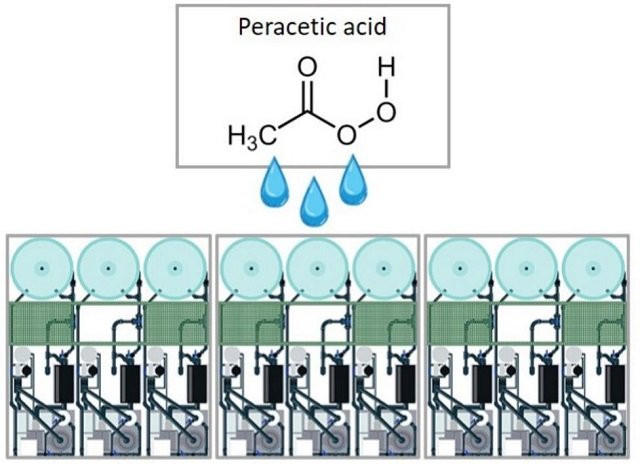
Atlantic salmon (Salmo salar) is increasingly farmed in recirculating aquaculture systems (RAS), which offer advantages such as controlled environments and reduced water usage. However, maintaining biosecurity in RAS is crucial for fish health. This is where peracetic acid (PAA) steps in as a potential game-changer.
A team of researchers from NTNU – Norwegian University of Science and Technology, UiT The Arctic University of Norway, Nofima AS, and Norwegian University of Life Sciences (NMBU) studied the long-term effects of PAA on salmon parr, which are raised in freshwater. The fish were exposed to different concentrations of PAA (0 mg/L, 0.1 mg/L, and 1 mg/L) for 28 days in RAS tanks. The researchers monitored water quality, fish health, and gene expression.
PAA: a powerful disinfectant
PAA is a potential disinfectant that can be used in RAS for several reasons:
- Strong oxidative properties: Effectively kills a wide range of pathogens, including bacteria.
- Safe for fish: Studies show that PAA in low concentrations has no lethal effects on various fish species, including Atlantic salmon.
- Rapid degradation: PAA quickly breaks down into harmless byproducts like oxygen and water, minimizing environmental impact.
- Reduced bioaccumulation risk: Unlike some disinfectants, PAA is unlikely to accumulate in fish tissues.
Water quality and fish health
- The study found that while PAA exposure caused a slight increase in bacterial populations, particularly at higher concentrations (1 mg/L), there were no significant negative impacts on water quality or fish health.
- Fish weight remained similar across all groups.
- No differences were observed in external signs of fish well-being or gill health.
- Oxidative stress markers, such as antioxidant capacity and reactive oxygen species, were not significantly affected.
Overall, this study suggests that PAA at the tested concentrations (0.1 mg/L and 1 mg/L) does not harm salmon parr health. However, the increase in bacteria raises questions about potential long-term effects on RAS biofilters.
The olfactory organ: the most responsive
Interestingly, the study identified changes in gene expression, particularly in the olfactory organ of the salmon (responsible for smell). This suggests that the olfactory system might be more sensitive to PAA exposure. Further research is needed to understand the long-term implications of these changes.
Promising future for RAS disinfection?
These findings are encouraging for the use of PAA as a disinfectant in RAS for Atlantic salmon. However, more research is needed to:
- Understand the long-term effects of PAA on RAS biofilters and bacterial communities.
- Refine PAA application methods to minimize bacterial growth.
- Investigate potential sublethal effects on fish at higher PAA concentrations or longer exposure times.
Conclusion
“This study shows that the calculated PAA concentrations of 0.1 mg/L and 1 mg/L in the pump sump contributed to an increase in bacteria, while no detectable differences were found in salmon health and well-being,” the researchers conclude, highlighting that “These findings are promising for the implementation of PAA-based disinfectants in RAS fed with Atlantic salmon.”
RAS technology offers a more sustainable approach to salmon farming by reducing water use and environmental impact; however, effective alternative inputs for system cleaning are needed. The potential of PAA as a safe and effective disinfectant could significantly contribute to the success of RAS for Atlantic salmon production.
Stay Always Informed
Join our communities to instantly receive the most important news, reports, and analysis from the aquaculture industry.
The study was funded by the Research Council of Norway, Young Research Talent Program.
Contact
Vasco C. Mota
Faculty of Science and Technology (REALTEK), Norwegian University of Life Sciences (NMBU)
1432 Ås, Norway.
vasco.mota@nmbu.no
Reference
Zhang, J., Eggen, M., Peruzzi, S., Klokkerengen, R., Sundfør, E., Odei, D. K., Timmerhaus, G., Asimakopoulos, A. G., Flaten, T. P., Lazado, C. C., & Mota, V. C. (2024). Effects of prolonged application of peracetic acid-based disinfectant on recirculating aquaculture systems stocked with Atlantic salmon parr. Science of The Total Environment, 942, 173762. https://doi.org/10.1016/j.scitotenv.2024.173762
Editor at the digital magazine AquaHoy. He holds a degree in Aquaculture Biology from the National University of Santa (UNS) and a Master’s degree in Science and Innovation Management from the Polytechnic University of Valencia, with postgraduate diplomas in Business Innovation and Innovation Management. He possesses extensive experience in the aquaculture and fisheries sector, having led the Fisheries Innovation Unit of the National Program for Innovation in Fisheries and Aquaculture (PNIPA). He has served as a senior consultant in technology watch, an innovation project formulator and advisor, and a lecturer at UNS. He is a member of the Peruvian College of Biologists and was recognized by the World Aquaculture Society (WAS) in 2016 for his contribution to aquaculture.




